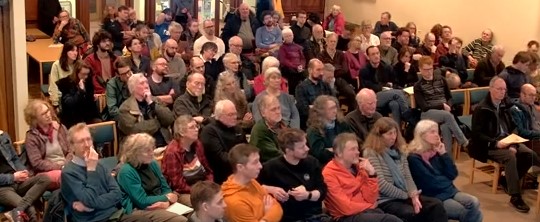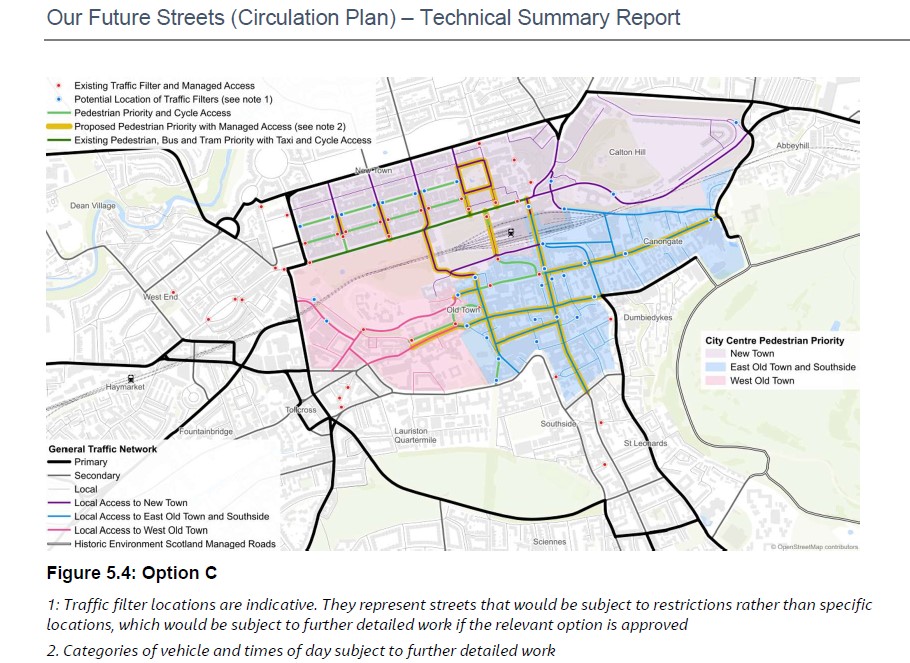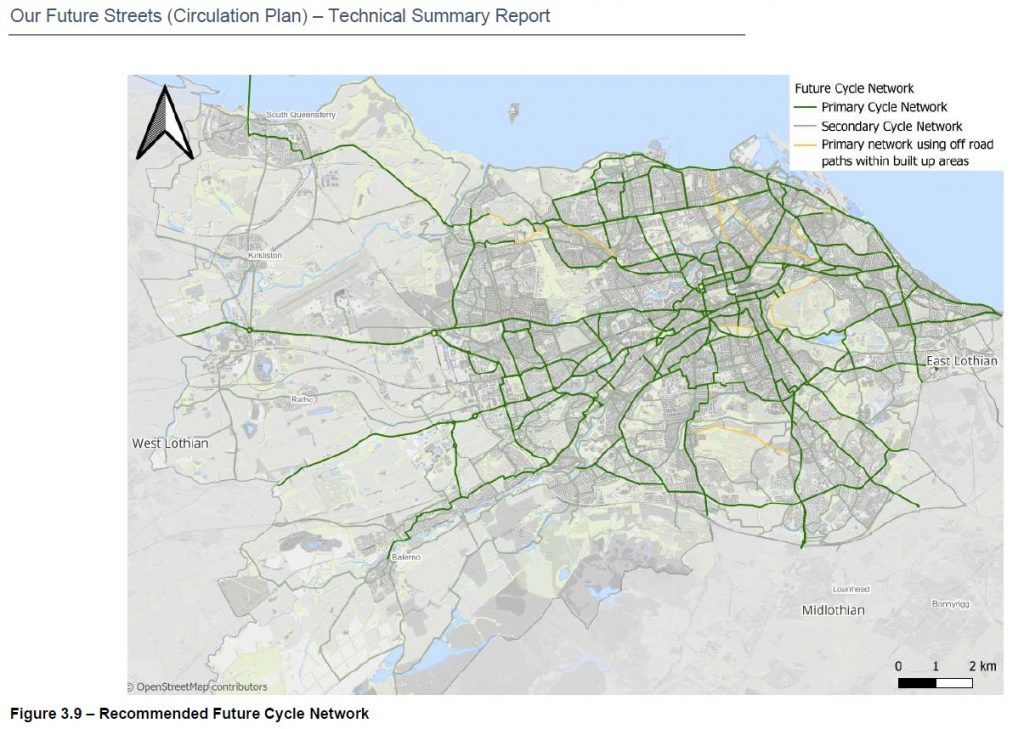Speaking at our public meeting on Edinburgh’s new transport policies, London-based environment and cycling journalist Laura Laker said that Edinburgh now appeared to be on the way to a less car-dominated city and a more coherent approach to transport policy, with public transport, walking and cycling at its heart. On cycling in particular, on this her third look at Edinburgh in 10 years, the city reminded her very much of London a few years ago at the start of its transformation of cycling conditions, which now comprise extensive, heavily-used and still expanding segregated cycling provision.
Around 100 members of the public attended our public meeting, with Transport Convener Cllr Scott Arthur stating he was delighted to get questions from “businesses, drivers and pedestrians as well as cyclists.”
A video recording of the entire meeting is available, together with the speaker slides – see ‘Resources’ below.

Speakers
Cllr Scott Arthur said two huge factors were pushing the need for rapid action – the transport implications of the ongoing expansion of the city, with 10s of 1000s of new homes coming in West, South and North Edinburgh, as well as the Lothians; and the climate crisis, which is worsening and will not put itself on hold for our convenience.
Public transport was a major success, with big increases in Lothian Buses patronage in the last year, and a doubling of tram patronage since the opening to Leith. Most bus routes have no subsidy, and indeed 30% of all bus trips in Scotland are now on Lothian Buses.
Politically, the minority nature of the Council (Labour has only 12 councillors out of 63) meant that any policy needed the support of 3 of the 5 main parties to get through, and this made for healthy consensus-building at the Transport & Environment Committee (TEC), with different party groupings combining on different policy decisions. Indeed, all 5 parties had agreed on the recent pavement parking ban, which could otherwise have been very controversial.
Laura Laker had spent the day cycling around new cycling and traffic-reduced locations, including of course Leith Walk (which she said illustrated the “growing pains” of the city’s approach) but also CCWEL, work on Roseburn to Canal, the Leith Connections low traffic neighbourhood and checking out the pavement parking ban and widespread 20mph.
She praised the concept of the new Circulation Plan, which should result in more coherent future cycling and wider transport development; rather than building individual projects without enough consideration of their roles as part of a network. London now had 1.26 million cycle trips per day, a demonstration of where Edinburgh could be by 2030 if its policies don’t slip.
Laura was also very impressed by the holistic nature of how cycling is treated in the Future Streets and Active Travel Action Plan documents – in addition to the vital cycle network, the plans included a host of related intentions – bike hire, school streets, cycleroute maintenance policies, cargo bikes for business, behaviour change, and much more. This approach would certainly help grow and maintain the number people using the cycle network.
Big Questions
The meeting was introduced by Emma Wildwood of Spokes, who referenced the following two critical aspects from the Future Streets policies
City Centre
The new plans agreed at the 1st Feb TEC include exciting proposals to remove through traffic from the city centre (diagram below) to: “create an extensive area between Lothian Road, Lauriston Place, Holyrood Park and Queen Street without general through / car traffic”.

Councillor Arthur told the meeting that it was hoped to remove through traffic from Cowgate late this summer, and to implement the full city centre plan in 2025. However the meeting was left with some uncertainties.
In the example of Ghent, which was described at Transport Committee, the removal of through traffic had been done overnight (after extensive preparation and publicity), but Cllr Arthur said that to do that here would result in huge time delays to buses using Lothian Road (though some other bus routes would gain speed). Bus delays would be a deciding factor in the details and the timescale. As a result, he said that officers were working on progressing the plan in stages. This did however leave us unclear how it would resolve the Lothian Road bus delays, and when the City Centre plan implementation would be complete.
He also said that the additional Lothian Road traffic would mean some losses in the Boulevard project, though wider footways and segregated cycling was still an objective. There would be particular traffic problems between the West Approach Road and the West End – which left us wondering about implications for the West End Junction, a top danger location in the Council’s Major Junctions Review.
City Cycle Network
Under the new Future Streets policy, the ‘Primary Cycle Network’ will be largely segregated routes on main roads. Most of Edinburgh’s often excellent offroad network is now called ‘secondary;’ this is not to downgrade its value but to recognise that its role is different to the primary network: as linking routes, connections to local areas, some remaining main connections, and of course a significant recreational purpose. We have not yet scrutinised the network map (below) carefully, but although welcoming the overall approach there are some concerns, particularly that the segregated onroad network should be fully connected.
The Cycle Network did not come up in the QA but, speaking after the meeting, Cllr Arthur said he recognised the urgency of implemention given the Council’s 2030 net-zero and 30% car-km reduction targets, but that much would depend on how much active travel cash the Council received from the Scottish Government. However, the Council was looking to a low-cost approach, perhaps on the lines of the recent Holyrood Road scheme, where segregation measures are added to the existing road surface rather than rebuilding everything as had been done in CCWEL. An intermediate option was the Glasgow trial of installing segregation kerbing into the existing road surface.

Questions & Answer
The hour-long QA was masterfully conducted by Ewen Maclean of Blackford Safe Routes.

The earlier part of this article has already covered several points from the QA. Here we pick out a few more of particular interest, though it is far from complete coverage. For the full QA, see the video recording. A couple of audience members (@bjpaddy and @davecykl) also did extensive tweeting during the QA, and you can see their tweets via the hashtag #SpokesMtg. Finally, Living Streets Edinburgh held an online QA with Cllr Arthur the following day. We have added one or two relevant points from that below.
Q: Granton tram: As expected, there were a couple of impassioned questions about the impact on nature and on walking and cycling opportunities if the tram uses Roseburn path rather than the Orchard Brae onroad route
SA (Scott Arthur): The public consultation (this summer) will present both options in full and equal detail, including cycling provision and cross-sections showing the amount of retained greenspace. The city is growing hugely and we are in a climate emergency, so a greatly enhanced and effective public transport network is essential.
Spokes note: See our website article on the pros and cons, for cycling onroad and offroad, and for transport more widely, of each option.
Q: Business impact: If Cowgate is closed, how will businesses and music venues be serviced?
SA: Closure will be to through traffic, but vehicular access to premises will remain. There will be detailed discussion with residents (via Community Councils) and all businesses to ensure deliveries etc are maintained, though may be at restricted hours. SA asks the questioner to email him to discuss. There is also a potential role for cargobikes for certain types of deliveries, and there are already some fledgling commercial operations in Edinburgh, including Zedify and Farrout.
LL (Laura Laker): This question always arises when cities take such steps, and solutions are always found.
Q: Potholes: Edinburgh is lethal; can money be diverted to that?
SA: It is a Scotland-wide, indeed UK-wide problem, with Edinburgh no worse than other councils. When the new council came in, two years ago, Edinburgh needed an extra £8m p.a. just to keep things as they were and prevent further deterioration. They increased the budget from £11m to £22m for 23/24 and now £23.5m for 24/25.
Q: Junction dangers: The greatest danger to cyclists and walkers is at junctions, yet segregated onroad cycle lanes often give up at these danger points. Will this change? Even at the Portobello junction site of 2 cyclist deaths in recent years, only temporary measures have been installed so far. Could automatic camera enforcement be used?
SA: Council has produced a Major Junctions Review, identifying the 40 worst junctions. Plans are to be drawn up to tackle all of them. Time and money will be needed for implementation, though some can be treated in a low-cost way. The Council is also seeking greater enforcement powers from Scot Govt (e.g. over camera enforcement) as the police do not have time/resources to police traffic sufficiently.
LL: This is difficult. Generally cyclists at junctions need to be separated from motor traffic either in space (i.e. facilities) or time (traffic lights). Manchester is introducing several cyclops junctions, though they are costly.
Q: Traffic reduction: Can the council reach its target of 30% car-km reduction by 2030? Will congestion charging be needed?
LL: Political will is a top requirement, also building up momentum with public engagement and a pipeline of projects, so that delays such as legal holdups don’t prevent work happening
SA: Edinburgh will do all it can, and the City Centre proposals will be a start. However, the 2030 outcome depends significantly on Scot Govt actions. They have still not published the long overdue final ‘Route Map’ to achieving their promised 20% car-km reduction*. Although Active Travel funding rose a little in the 24/25 Scot Govt budget, it is £100m less than had been promised. Better public transport is essential given the numbers involved, but the budget also halted the £500m Bus Partnership Fund for a year, whilst also cutting rail by £80m and adding £210m to trunk roads.
Lothians towns are expanding, yet trains from the east and south are already crammed; and the long-promised Winchburgh station is still in limbo, so what Edinburgh can achieve also depends in part on what neighbouring councils do – and they are all signed up to SEStran which has adopted the Scot Govt 20% car-km reduction target.
Congestion charging is a blunt tool for councils. Road pricing, which can be adjusted for time of day, type of vehicle, etc, is preferable, but again requires government action – probably UK level.
*Spokes note: The Scot Govt ‘commitment’ (not ‘target’) to reduce car-km 20% by 2030 was first announced in December 2020. A draft routemap on how to achieve this was published for consultation in Jan 2022, and now, in March 2024, the final version has still not appeared. Sources in this article.)
Q: Use of footways: Does bike parking need to be on the footway?
SA: Hopes to see more future Sheffield racks going into car parking spaces rather than on footway. One car space can hold many bikes. Ditto for future bike hire stations (and a report on bike hire is coming to the April TEC)
Q: Picardy Place: (at the Living Streets online meeting) What will be done about the congestion and resulting traffic fumes?
SA: Picardy Place is under review, with a report to TEC due in April. The basic problem is the total amount of traffic in the city, hence the need for the complete Future Streets policy and public/active transport investment. The City Centre plan, closing North Bridge to through traffic, will help Picardy Place a lot, and may even mean that the gyratory can eventually be removed.
Spokes note: When North Bridge is closed to private traffic, the much-campaigned-for extension of Leith Street cycle lane up the hill to Waterloo Place must surely be installed at the same time.
Resources
- Pre-meeting article, with outline discussion of Future Streets policies, including relevant maps and links to relevant documents
- Complete video of the meeting Chapters are listed in the text below the video, should you wish to go straight to a particular section of the meeting
- Cllr Scott Arthur slides (compressed to 22MB)
- Laura Laker slides (compressed to 13MB)
- Living Streets Edinburgh held a subsequent mtg on the city centre only
- Previous Spokes public meetings
What you can do
- If anything in this article encourages, dismays or puzzles you, why not email your councillors for their thoughts or asking them to take action. Find Edinburgh councillors here. For MSPs, MPs and councillors in any other council, use www.writetothem.com.
- Retweet our tweet about this article.
And for the conspiracy theorists on social media …
Yes, our public meetings are exactly that, public meetings, open to all!


